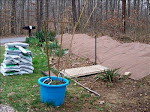This year, for the first time, I'm using row covers. I find them difficult to work with. They tear easily and it's especially hard to remove all the ground staples to lift the cover to work on the rows beneath it. I uncovered one row yesterday and within an hour some critter munched on the leaves. Slugs?
Tuesday, April 8, 2014
I'm trying out straw bales for the first time. I found this article helpful. He gives instructions on prepping the bales.
http://modernfarmer.com/2013/07/straw-bale-gardening/
http://modernfarmer.com/2013/07/straw-bale-gardening/
Gardening with Straw Bales
Two weeks of conditioning and I'll be ready to plant in these bales. The tree limbs are from my stash and we wove them together. I packed clay soil around the bases of the poles. Next I'll wrap the whole thing in plastic to speed up the bale's breakdown. I use urine to break mine down.
Two weeks of conditioning and I'll be ready to plant in these bales. The tree limbs are from my stash and we wove them together. I packed clay soil around the bases of the poles. Next I'll wrap the whole thing in plastic to speed up the bale's breakdown. I use urine to break mine down.
Wednesday, February 26, 2014
Zone 7
With lower elevations and longer days, a variety of vegetables will thrive in a Zone 7 garden. Lettuce, cabbage, broccoli and Brussels sprouts can be planted before the last frost. Carrots, beets, radishes, and parsnips will also do well. Onions, potatoes, peas, radishes, salad greens, and a variety of herbs can also be planted during this time frame. Most areas in zone 7 get moderate to high rainfall and many areas have little snowcover in winter. This makes zone 7 gardening an ideal gardening environment. Fall-grown vegetables, in particular, are usually of very high quality.Monday, February 24, 2014
Subscribe to:
Comments (Atom)


















